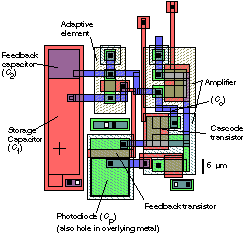Adaptive Photoreceptor Circuit
The original adaptive photoreceptor circuit is described in a long, rather tutorial version of about
25 pages, and a greatly shortened extract prepared for ISCAS 94. The most recent photoreceptor paper in ISCAS2004 is about an extremely low power self-biasing version of the circuit.
- The full paper: T. Delbrück and C.A.Mead. (1995). Analog VLSI phototransduction by continuous-time, adaptive, logarithmic photoreceptor circuits, in Vision Chips: Implementing vision algorithms with analog VLSI circuits, C. Koch and H. Li editors, IEEE Computer Society Press, 1995, pp. 139-161
- The short paper: T. Delbrück, C.A.Mead. (1994) Analog VLSI adaptive logarithmic wide-dynamic-range photoreceptor, 1994 International Symposium on Circuits and Systems, London, pp. 339-342.
- The self-biasing photoreceptor: T. Delbruck, D. Oberhof, Self biased low power adaptive photoreceptor, 2004 International Symposium on Circuits and Systems (ISCAS 2004), Vancouver, Canada, May 23-25 2004 pp. IV-844-847
- Semester project report 2003, Daniel Oberhoff, Low power photoreceptor stability
- Our original paper about adaptive photoreceptors (how dated and naive it now seems): T. Delbruck, C. Mead. (1989). An electronic photoreceptor sensitive to small changes in intensity (bitmap PDF), Advances in Neural Information Processing Systems 1, D.S. Touretzky, Ed., Morgan Kaufman, San Mateo CA, pp. 720-726.
Simulating photoreceptors with SPICE
If you are using SPICE to simulate the photoreceptor, you may want to
have a look at this PDF note about simulation of junction diodes.
Radiometry and photometry units for image and vision sensor developers
(relating chip illumination to scene illumination), see these Notes on practical photometry, rewritten from the Pulsed-Bipolar imager project. There is a magic formula relating chip illumination to scene illumination explained (albeit very concisely) and the error that existed previously is now corrected (Feb 2006). These notes also explain photometry units: nits, candela, lumens, lux, and they relate incident illumination to luminance of a surface.
An adaptive photoreceptor circuit can be
used in massively parallel analog VLSI silicon chips that compute vision problems in continuous time.

The receptor provides a continuous-time output that has low gain for
static signals (including circuit mismatches), and high gain for
transient signals that are centered around the adaptation point. The
response is logarithmic with illumination, which makes the response to
a fixed image contrast invariant to absolute light intensity. 
The 5-transistor receptor can be fabricated in an area of about 60 by
60 µm2 in a 2µm single-poly CMOS technology. It has a
dynamic range of 1 to 2 decades at a single adaptation level, and a total
dynamic range of more than 6 decades. Several technical improvements in
the circuit yield an additional 1 to 2 decades dynamic range over previous
designs without sacrificing signal quality. The lower limit of the
dynamic range, defined arbitrarily as the illuminance at which the
bandwidth of the receptor is 60 Hz, is at approximately 1 lux, which is
the border between rod and cone vision and also the limit of current
consumer video cameras.
The layout looks like this: 
We describe an adaptive element that is resistant to excess minority
carrier diffusion. We show measurements of the effectiveness of guard
structures, and of the spectral sensitivities of devices that can be
built in a BiCMOS process. The logarithmic transduction process makes
the time constant scale inversely with intensity. As a result, the
total A.C. RMS receptor noise is constant, independent of intensity.
The spectral density of the noise is within a factor of two of photon
shot noise and varies inversely with intensity. The connection between
shot and thermal noise is beautifully illustrated. 
The noise properties of subthreshold transistors is discussed much
more fully in a paper by Rahul
Sharpeskar, Tobi Delbruck, and Carver Mead.
Tobi Delbruck
September 13, 2007